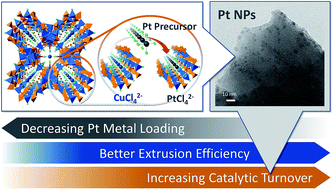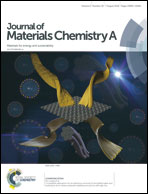Spectroscopic insights leading to a better understanding of site-isolation in heterogeneous nanocatalysts†
Abstract
Pt nanoparticles (NPs) extruded from a copper chloropyrophosphate (CuClP) framework have been synthesized with different metal loadings and evaluated in the KA oil oxidation with molecular oxygen. Before reaction, the catalysts were subjected to an activation procedure in reducing atmosphere at 200 °C in order to extrude the Pt NPs. Having a optimal loading of active sites (Pt nanoparticles) leads to superior turnover frequencies and a combined structural and spectroscopic approach was used to probe the nature of the extruded nanoparticle catalysts. For the first time, we were able to track the extrusion and NP formation through the use of PXRD and DR UV-Vis-NIR spectroscopy, monitoring the effective inclusion of [PtCl4]2− anions from the metal precursor within the 1D channels of the framework, during the synthesis and associated extrusion process. A direct correlation between the degree of extrusion and catalytic performance has been proposed and the importance of site-isolation in achieving high catalytic turnovers has been emphasized, on the basis of the spectroscopic analysis that has been carried out. HR-TEM analysis showed the presence of homogeneous and highly dispersed Pt NPs, which further illustrated the structural and compositional integrity of the supported nanoparticles, post catalysis. Interestingly, a narrower particle size distribution at optimal metal loadings (3 wt% Pt) was found, further vindicating the importance of designing uniformly-distributed metal nanoparticles for continuous-flow oxidation processes. Furthermore, our investigations on NP–substrate interactions through probe-based in situ FT-IR studies, provides unique insights on the catalytic reaction, by precisely tracking the main steps involved in the oxidation process. Cyclohexanol molecules interact with the catalyst through the OH group without decomposing until 150 °C, and its subsequent oxidation to cyclohexanone is evidenced at 200 °C.



 Please wait while we load your content...
Please wait while we load your content...